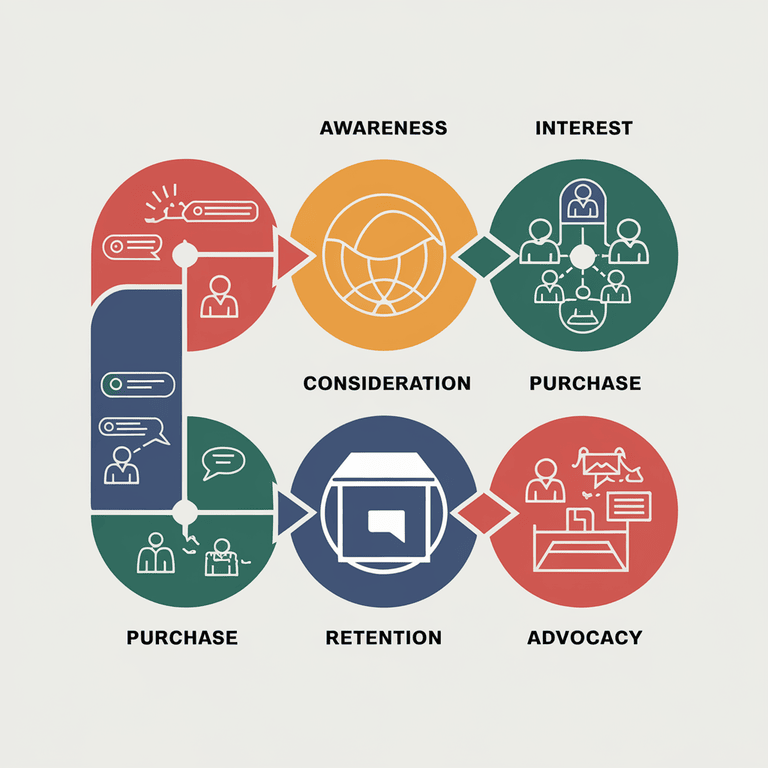In digital marketing, understanding how your efforts translate into results is crucial. This is where SEO attribution modeling comes into play. SEO attribution modeling allows businesses to track and measure the impact of their SEO efforts across various touchpoints in the customer journey. By understanding this, companies can optimize their SEO strategies and make better-informed decisions.
In this article, we’ll explore what SEO attribution modeling is, the different models available, and how artificial intelligence (AI) is transforming this process to offer better insights and accuracy.

How AI Enhances SEO Attribution Modeling
Artificial Intelligence (AI) is revolutionizing how businesses approach SEO attribution modeling. Traditional models often rely on static data and assumptions, which can lead to inaccuracies. AI, on the other hand, leverages machine learning and real-time data to deliver more precise, dynamic attribution insights.
Role of AI in Improving Data Accuracy
AI enhances data accuracy by analyzing vast amounts of data from multiple sources in real-time. Traditional attribution models might miss critical interactions, while AI can track complex customer journeys across different devices, platforms, and touchpoints.
With AI-powered tools, marketers no longer have to rely on simple, linear models. AI can analyze patterns in user behavior and predict how likely a user is to convert based on past interactions.
Machine Learning for Better Customer Journey Analysis
Machine learning algorithms continuously learn from new data, enabling businesses to refine their attribution models. For example, machine learning can identify the most important touchpoints or keywords that drive conversions, even if those touchpoints aren’t immediately obvious.
With machine learning, businesses can understand customer behavior better, uncovering insights like:
- Which content performs best for different stages of the funnel
- How users move between touchpoints
- The timeframes in which conversions typically occur
Predictive Capabilities of AI in Attribution Modeling
AI doesn’t just look at historical data; it predicts future outcomes. By analyzing patterns in customer behavior, AI can forecast the likelihood of a conversion happening based on earlier touchpoints. This is particularly helpful for businesses in optimizing their SEO campaigns in advance.
For example, an AI-powered attribution model can help you predict which keywords or blog posts will likely drive conversions in the coming weeks, allowing you to prioritize them.
Real-Time Adjustments and Optimization with AI
One of the most exciting aspects of AI in SEO attribution is the ability to make real-time adjustments. AI can detect changes in user behavior or market conditions and adjust attribution models accordingly.
This real-time optimization ensures that businesses are always working with the most up-to-date data, and it enables faster decision-making. It can also uncover trends in the customer journey as they emerge, giving marketers an edge over competitors.
Examples of AI-Powered Attribution Tools for SEO
Several AI-powered attribution tools are transforming how SEO efforts are tracked and optimized. Some popular options include:
| Tool Name | Key Features | Best For |
|---|---|---|
| Google Analytics 4 | Machine learning insights, predictive metrics, user behavior tracking | Businesses of all sizes |
| HubSpot | AI-driven insights, multi-channel tracking, SEO performance analysis | Marketing teams looking for an integrated solution |
| Attribution | Cross-channel attribution, AI-based reports, predictive modeling | Enterprises with complex sales cycles |
| Scalable | Real-time attribution modeling, SEO-focused insights | Companies focused on SEO and growth |
These tools use AI to automate the attribution process and provide businesses with powerful insights into their SEO strategies.
Challenges of SEO Attribution Modeling
While SEO attribution modeling offers many benefits, it’s not without its challenges. Businesses must navigate issues related to data quality, multi-channel tracking, and privacy concerns.
Data Quality and Accuracy Issues
Accurate data is at the core of any attribution model, but not all data is created equal. Low-quality data—whether it’s incomplete, inconsistent, or outdated—can skew your attribution results. Without clean data, even the most sophisticated attribution model won’t be effective.
For example, if you’re using keyword data from outdated sources, you may overlook trends in current search behavior, leading to misguided decisions.
Difficulty in Tracking Multi-Channel Interactions
In today’s digital landscape, users interact with brands across multiple channels and devices. Tracking these interactions can be tricky. A customer may discover your brand through an organic search on their phone, return via a paid ad on their laptop, and finally convert on social media.
Traditional attribution models struggle to account for this complexity, which is why AI-powered solutions are gaining popularity. AI tools excel at tracking these multi-channel interactions and providing a more accurate picture of the customer journey.
Ensuring Privacy and Ethical Handling of User Data
Privacy concerns have become a major issue in the digital marketing space. With stricter regulations like GDPR and CCPA, businesses need to be cautious about how they collect and store user data. AI tools that track customer behavior and interactions must ensure they comply with privacy laws.
Marketers need to strike a balance between using AI to gain insights and respecting user privacy. Ethical data collection and transparent policies are essential for maintaining trust with your audience.
Balancing Complex Attribution Models with Simplicity
While AI offers powerful attribution capabilities, it’s important to strike a balance between complexity and simplicity. Attribution models that are too complicated can overwhelm marketers and lead to confusion. It’s essential to select a model that provides valuable insights without being unnecessarily complex.
The key is to choose the right model for your business goals. While AI can handle complex data, you still want a clear, actionable understanding of your SEO performance.

How to Choose the Right SEO Attribution Model for Your Business
Choosing the right attribution model is a critical step in optimizing your SEO efforts. Each business has unique goals, and the attribution model you choose should align with those objectives.
Identifying Business Goals and SEO Objectives
Before selecting an attribution model, take the time to define your business goals. Are you looking to acquire new customers, retain existing ones, or optimize conversions? Each objective may require a different attribution approach.
For example, if you’re focused on driving awareness, a first-touch attribution model might work best. If your goal is to convert prospects into customers, last-touch attribution could be more effective.
Analyzing Customer Behavior and Touchpoints
Understanding your customer’s journey is crucial to selecting the right attribution model. Consider the key touchpoints that influence conversions. Do customers discover your brand through blog posts, paid ads, or organic search? Mapping out the customer journey will help you identify the most influential touchpoints.
Use tools like Google Analytics or AI-powered attribution tools to analyze these behaviors in detail. These insights will guide you in choosing the most appropriate model.
Matching Attribution Models to Marketing Strategies
Once you understand your goals and customer behavior, match your attribution model to your marketing strategies. If you’re running a multi-channel campaign, consider using a linear or position-based model to get a comprehensive view of performance. For businesses with short sales cycles, last-touch attribution might provide more useful insights.
Testing and Refining Models Over Time
Attribution models are not set in stone. Over time, you should test and refine your models to improve their accuracy. The digital marketing landscape evolves, so your attribution model should evolve with it. A/B testing can be a useful approach for comparing different models and refining your strategies.
What is SEO Attribution Modeling?
SEO attribution modeling assigns credit to different marketing touchpoints in the customer journey, leading to conversions. In other words, it helps marketers understand which SEO efforts (keywords, content, backlinks, etc.) influence a particular action, like a purchase or sign-up.
Attribution models help businesses evaluate the effectiveness of each SEO touchpoint. This data is crucial for:
- Identifying high-performing channels
- Understanding the customer’s decision-making process
- Allocating marketing resources effectively
- Improving SEO campaigns for better results
For example, if someone finds your website through a blog post and later converts through a product page, SEO attribution models help you understand that the blog post played a role in the conversion.
Key Metrics Impacted by SEO Attribution
SEO attribution modeling provides insights into various metrics that help businesses understand SEO performance, such as:
- Organic Traffic: How many visitors come from organic search results?
- Conversion Rate: How many visitors are taking action (e.g., purchasing or signing up).
- Customer Lifetime Value (CLV): The total revenue a customer will generate over their lifetime.
- Lead Generation: How many potential customers are captured during their journey?
These metrics are essential for evaluating and improving SEO efforts, ensuring businesses invest in the right strategies and optimize their resources effectively.
Why SEO Attribution Modeling Matters for Digital Marketing
Understanding the effectiveness of SEO efforts is not always straightforward. The customer journey is often long and involves multiple touchpoints across different channels. SEO attribution modeling helps marketers make sense of this complex process by giving them a clearer picture of how SEO influences conversions.
Understanding the Customer Journey in SEO
The customer journey is rarely linear. A potential customer might interact with your brand through various touchpoints—like social media, blog posts, or search engine results—before making a final decision. SEO attribution modeling helps you connect these touchpoints and understand which ones were most influential in driving the conversion.
How Accurate Attribution Helps with Resource Allocation
Without attribution, businesses risk spending resources on ineffective strategies. You can allocate resources more effectively by identifying which SEO efforts contribute most to conversions. For example, if a specific type of blog post drives more traffic than others, you can create more content in that category to boost results.
Role in Optimizing SEO Strategies and Campaigns
SEO attribution modeling provides actionable insights into which aspects of your SEO strategy are working well and which need improvement. By regularly analyzing your attribution data, you can tweak your plan, whether improving on-page content, refining keyword targeting, or boosting backlinks. This ongoing optimization is key to staying competitive in a constantly evolving digital landscape.
Types of SEO Attribution Models
Several attribution models are available, each offering a unique way of distributing credit across different touchpoints. Understanding these models can help you choose the one that best aligns with your goals.
First-Touch Attribution
The first-touch attribution model assigns 100% of the credit to the first touchpoint that led to the conversion. This model is helpful for businesses that want to understand how customers initially discover their brand.
When to use it:
- You’re focused on customer acquisition and awareness.
- Your goal is to identify which channels or content generate the most interest.
Last-Touch Attribution
In last-touch attribution, all the credit for the conversion goes to the final touchpoint before the conversion occurs. This model is often used to measure the effectiveness of your closing efforts, such as a well-optimized product page or final call-to-action.
When to use it:
- You’re focused on the final stages of the customer journey.
- Your main concern is driving conversions, like sales or sign-ups.
Linear Attribution
Linear attribution assigns equal credit to each touchpoint in the customer journey. This model is beneficial for businesses that want a balanced view of the entire customer journey.
Benefits:
- Fairly distributes credit across all touchpoints.
- Useful for businesses looking to understand the holistic impact of their SEO efforts.
Ideal scenarios:
- When there is no dominant touchpoint, and you want to understand the full scope of your marketing efforts.
Time-Decay Attribution
The time-decay attribution model gives more credit to the touchpoints closer to the conversion, with diminishing credit for earlier touchpoints. This model reflects the idea that the closer a touchpoint is to the conversion, the more influence it has.
When to use it:
- When your sales cycle is relatively short, and the last few interactions are key in driving conversions.
- For businesses that focus on remarketing or closing sales.
Position-Based Attribution
In position-based attribution, the first and last touchpoints receive the most credit, while the middle touchpoints share the remaining credit evenly. This model is ideal for businesses that want to give weight to both the initial and final interactions.
Best use cases:
- Businesses with long sales cycles where both awareness and final conversion are equally important.
- When you want to highlight the most influential first and last interactions.
Custom Attribution Models
Custom attribution models are designed to fit unique business needs. These models can combine elements from different attribution models or be completely tailored to the specifics of your customer journey.
Benefits:
- Flexibility in assigning credit based on specific business objectives.
- More precision in tracking conversions and understanding customer behavior.
Custom models are ideal for businesses with complex customer journeys that need a personalized approach to attribution.

Best Practices for Implementing SEO Attribution Modeling
Implementing an SEO attribution model that works for your business involves more than just choosing the right model. It requires thoughtful integration, continuous optimization, and alignment with your overall marketing strategy. Here are some best practices to ensure successful SEO attribution modeling:
Integrating SEO Data with Other Marketing Channels
SEO doesn’t exist in a vacuum. Most businesses use multiple marketing channels—like social media, email, and paid ads—so it’s crucial to integrate your SEO attribution with other marketing data. When you have a complete view of all channels, you can accurately attribute credit to SEO’s role in the customer journey.
Best practices for integration:
- Use marketing automation tools like HubSpot or Salesforce to centralize data from all channels.
- Track customer interactions across platforms to get a comprehensive view.
- Leverage multi-channel attribution models to better understand how SEO interacts with other channels.
Aligning Attribution Models with Business KPIs
The success of your attribution model depends on how well it aligns with your business KPIs (Key Performance Indicators). If your business’s main goal is to generate leads, your attribution model should prioritize lead generation touchpoints. If your focus is on sales, your attribution model should emphasize conversions.
Examples of KPIs to consider:
- Leads generated: Track form submissions, demo requests, or newsletter sign-ups.
- Sales conversions: Measure how many visitors actually make a purchase.
- Customer retention: Understand how SEO impacts repeat purchases or brand loyalty.
Aligning your attribution model with these KPIs ensures that you’re capturing the right data and making decisions that support your business objectives.
Regularly Updating Models with New Data
The digital landscape is always changing. New trends, algorithms, and consumer behaviors can alter the effectiveness of your SEO efforts. That’s why it’s essential to regularly update your attribution models with new data.
AI-powered tools make this process easier by automatically updating models as new data comes in. However, it’s still important to periodically review your model and ensure it reflects the current market conditions.
How to keep your models up-to-date:
- Regularly check your analytics for new trends or shifts in customer behavior.
- Update your model to reflect changes in marketing channels or tactics.
- Test new models and refine them based on performance data.
Leveraging AI Tools to Streamline Attribution Processes
AI tools can help automate and streamline the attribution process, freeing up valuable time for marketers. These tools use machine learning to provide real-time data analysis, making it easier to identify trends and make adjustments.
For example, AI can help you:
- Automate the collection and analysis of SEO data
- Provide actionable insights and recommendations based on real-time data
- Identify opportunities for optimization across different SEO efforts
Using AI tools not only makes attribution more efficient but also improves the accuracy of the insights you receive.
Breaking It All Down
SEO attribution modeling is a vital tool for understanding how SEO efforts impact your business. By choosing the right attribution model, integrating AI-powered tools, and continuously refining your strategy, you can improve your SEO performance and maximize your marketing efforts.
AI is transforming attribution modeling by providing real-time data, predictive insights, and seamless integration with other marketing channels. With the right tools and best practices, businesses can unlock powerful insights that drive better results and improve their overall SEO strategy.
So, if you’re ready to take your SEO attribution to the next level, it’s time to embrace AI-powered tools and implement a model that works best for your business. By tracking, analyzing, and optimizing your SEO efforts, you’ll be in a better position to meet your marketing objectives and succeed in today’s competitive digital landscape.
Frequently Asked Questions
What is the difference between SEO attribution and traditional marketing attribution?
SEO attribution focuses specifically on the role SEO efforts (like organic search traffic, backlinks, and content) play in the customer journey, whereas traditional marketing attribution may encompass all types of marketing efforts, including paid ads, email marketing, and social media. SEO attribution models isolate the contribution of SEO in driving conversions, helping businesses optimize their organic strategies.
Can I use AI to improve my existing SEO attribution model?
Yes, AI can significantly enhance your existing attribution model. By incorporating AI, you can automate data collection, analyze customer behavior more accurately, and make real-time adjustments based on fresh data. AI also enables predictive capabilities, helping you forecast which SEO tactics will likely drive future conversions. It can make your attribution model more dynamic and actionable.
How do I know which attribution model is right for my business?
Choosing the right attribution model depends on your business goals and the complexity of your customer journey. If you’re focused on brand awareness, a first-touch attribution model may work best. If conversions are your primary goal, last-touch attribution might be more effective. For a balanced approach, consider a linear or position-based model. It’s essential to align your attribution model with your specific marketing objectives and the insights you want to gain.
How does AI predict future SEO trends?
AI can analyze historical data and detect patterns in customer behavior, allowing it to forecast future trends. For SEO, this means predicting which keywords, topics, or strategies will likely lead to higher conversions. AI tools can analyze competitor behavior, emerging search trends, and shifts in consumer intent, offering businesses a proactive approach to SEO rather than a reactive one.
How do I integrate multiple marketing channels into my SEO attribution model?
To integrate multiple channels, you’ll need a tool or platform that can track data across various touchpoints, such as Google Analytics 4, HubSpot, or other multi-channel attribution platforms. These tools allow you to see how different channels (paid search, social media, email, etc.) contribute to SEO results. By integrating data from all channels, you can get a clearer picture of how SEO works with other marketing efforts and optimize your strategy accordingly.
Is it possible to track SEO attribution across multiple devices?
Yes, it is possible to track SEO attribution across multiple devices. AI-powered tools can monitor user behavior across different devices and sessions, offering a complete view of the customer journey. This cross-device tracking allows businesses to understand how users interact with their website from various touchpoints, including smartphones, tablets, and desktops, and attribute the right amount of credit to each interaction.
How does AI handle privacy concerns with SEO attribution?
AI tools that track SEO attribution are designed to comply with data privacy regulations like GDPR and CCPA. They anonymize user data and aggregate insights without compromising individual privacy. Ethical AI tools ensure transparent data collection practices and give users control over their data, all while providing businesses with accurate attribution insights.
Can attribution models be used for content marketing in addition to SEO?
Yes, attribution models can be applied to content marketing efforts as well. Content marketing plays a crucial role in driving SEO traffic, and using attribution modeling allows businesses to understand which content pieces (blogs, videos, social posts) are most effective in leading to conversions. By tracking content performance across the customer journey, businesses can refine their content strategies to optimize results.
How often should I update my attribution model?
It’s a good idea to review and update your attribution model regularly to ensure it reflects the latest changes in your marketing strategy, customer behavior, and industry trends. AI-powered tools can make this process easier by automatically adjusting attribution models as new data comes in. However, you should still review your models quarterly or biannually to ensure they are still aligned with your business goals.
Can attribution models help identify SEO opportunities?
Yes, attribution models can highlight areas for improvement in your SEO strategy. By analyzing which touchpoints or content contribute most to conversions, you can identify gaps or opportunities for new SEO efforts. For example, if a certain type of blog post consistently drives conversions, you may want to create more content around that topic or format. Attribution models help guide decisions about where to focus your SEO resources for the best return on investment.
Offsite Resources
Moz – A leader in SEO tools and resources, Moz offers a wealth of information on SEO best practices and attribution modeling.
HubSpot – HubSpot provides comprehensive marketing, sales, and customer service solutions, including SEO attribution tools and guides.
Google Analytics – Google’s official website for analytics tools, which is vital for tracking SEO performance and integrating attribution models.
Search Engine Journal – A great resource for the latest trends and best practices in SEO, including articles on attribution modeling and AI tools.
SEMrush – SEMrush is an SEO platform that provides detailed reports on SEO performance and attribution insights.
MarketingProfs – MarketingProfs offers a wealth of articles, webinars, and resources on marketing strategies, including SEO attribution.
Kissmetrics – A data analytics and attribution platform that helps businesses understand the customer journey and optimize SEO efforts.

What's Next?
A quick reminder to all small business owners: The SEO tips on this page were provided by our co-founder, Matt LaClear. With over 13,277 SEO campaigns under his belt since 2009, Matt brings a wealth of experience and proven strategies to help your business succeed online.
Don’t miss out on his special offer – take advantage of a free custom SEO strategy call. This is a great opportunity to get personalized insights and actionable steps for improving your SEO and growing your business. Reach out today and see how Matt’s expertise can make a difference for you!

